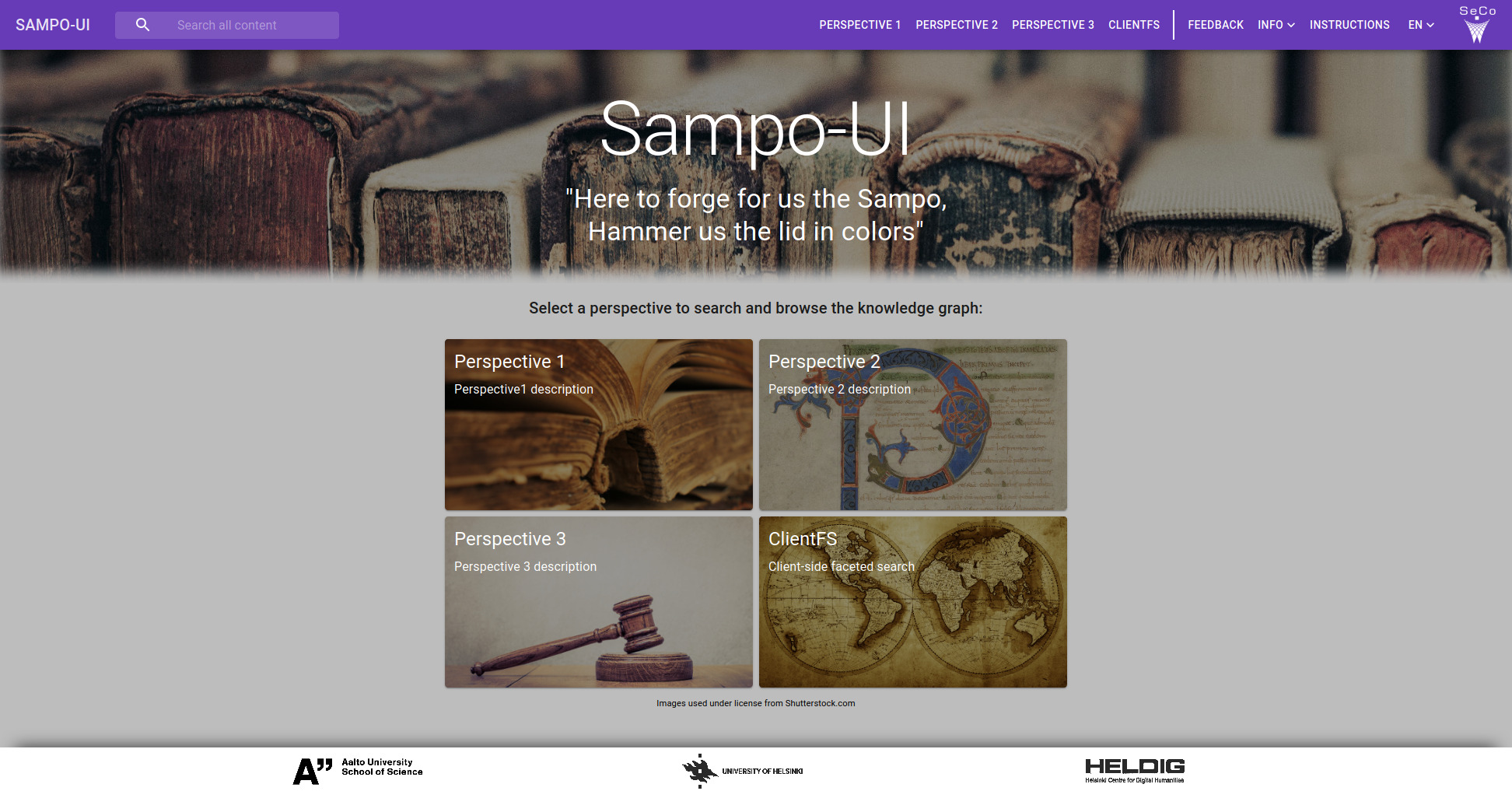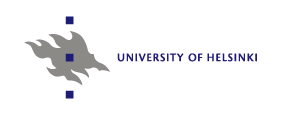Sampo-UI
Sampo-UI is a framework for developing user interfaces for semantic portals (Ikkala et al., 2022).
The underlying ideas
of the framework are based on the "Sampo" model that contains a sustainable business model for publishing
and sharing Linked Data based on a shared ontology infrastructure, the idea of providing the end user with
multiple application perspectives to the Linked Data, and a two-step usage cycle based on faceted search
combined with ready-to-use data-analytic tooling (Hyvönen, 2023).
The framework draws from longstanding research of the
Semantic Computing Research Group (SeCo) since 2002 on developing a
national Semantic Web infrastructure
in Finland and semantic portals, which has resulted in publishing
a series of "Sampo portals", mostly related to the Cultural Heritage domain, that have had millions of end users on the Web.
The Sampo-UI framework makes it possible to create highly customizable and responsive
user interfaces that satisfy the requirements for such portals using current state-of-the-art JavaScript
libraries and data from SPARQL endpoints, while saving substantial coding effort. Sampo-UI is published on
GitHub under the open MIT License and has been utilized in several internal and external projects.
For more information about the "Sampo" model and how Sampo-UI has been applied in semantic portals see the
Sampo portals homepage.
Open Software Available
Sampo-UI is available on GitHub: https://github.com/SemanticComputing/sampo-ui.
Tutorial: How to Create a Semantic Portal Using the Sampo-UI Framework
Sampo-UI has turned out to be an easy to use and efficient tool for developing portals on SPARQL endpoints:
it has been used no only by its developers in the SeCo research group but also by external users.
A detailed tutorial
is available explaining how to install the needed sofware a and configue a template portal
easily for a new application on top of basically any SPARQL endpoint.
There is also a video available on how to create a Sampo portal using Sampo-UI.
Demo Portal
An example portal built with the latest version of Sampo-UI is published at
sampo-ui.demo.seco.cs.aalto.fi.
It combines sample perspectives and templates from existing portals, and can be used
for testing and as a "starting base" for developing new user interfaces.

Figure: Sampo-UI's default stucture for a landing page of semantic portal.
Contact:
MSc Heikki Rantala
Aalto University, Semantic Computing Research Group
firstname.lastname@aalto.fi
MSc Annastiina Ahola
Aalto University, Semantic Computing Research Group
firstname.lastname@aalto.fi
Prof. Eero Hyvönen
Aalto University and University of Helsinki (HELDIG)
firstname.lastname@aalto.fi
Publications
2025
Eero Hyvönen, Petri Leskinen, Henna Poikkimäki, Heikki Rantala, Jouni Tuominen, Senka Drobac, Ossi Koho, Ilona Pikkanen and Hanna-Leena Paloposki:
LetterSampo Finland (1809–1917) Data Service and Portal: Searching, Exploring, and Analyzing Historical Letters and Their Underlying Networks.
The Semantic Web: ESWC 2025 Satellite Events, Portoroz, Slovenia, June 1 - 5, 2025, Proceedings, Lecture Notes in Computer Science, vol. 15832, pp. 80-86, Springer-Verlag, 2025.
bib pdf link Eero Hyvönen, Annastiina Ahola, Petri Leskinen and Jouni Tuominen:
SampoSampo: A Portal for Studying Enriched Data and Semantic Connections on a Cultural Heritage Linked Open Data Cloud.
The Semantic Web: ESWC 2025 Satellite Events, Portoroz, Slovenia, June 1 - 5, 2025, Proceedings, Lecture Notes in Computer Science, vol. 15832, pp. 67-74, Springer-Verlag, 2025.
bib pdf link Eero Hyvönen, Petri Leskinen, Henna Poikkimäki, Heikki Rantala, Refael Leal, Jouni Tuominen, Senka Drobac, Ossi Koho, Ilona Pikkanen and Hanna-Leena Paloposki:
Searching, exploring, and analyzing historical letters and the underlying networks: LetterSampo Finland – Finnish 19th-Century Letters on the Semantic Web.
Digital Humanities in Nordic and Baltic Countries 2025 (DHNB 2025), Post-proceedings, University of Oslo Library, Norway, September, 2025. Accepted, forth-coming.
bib pdf Sarah Binta Alam Shoilee, Annastiina Ahola, Heikki Rantala, Eero Hyvönen, Victor de Boer, Jacco van Ossenbruggen and Susan Legene:
Enhancing Provenance Research with Linked Data: A Visual Approach to Knowledge Discovery.
Proceedings of the Second International Workshop of Semantic Digital Humanities (SemDH 2025), co-located with the Extended Semantic Web Conference 2025 (ESWC 2025), vol. 4009, CEUR Workshop Proceedings, June, 2025.
bib pdf link Eero Hyvönen, Petri Leskinen, Henna Poikkimäki, Heikki Rantala, Jouni Tuominen, Senka Drobac, Ossi Koho, Ilona Pikkanen and Hanna-Leena Paloposki:
Searching, exploring, and analyzing historical letters and the underlying networks: LetterSampo Finland (1809–1917) data service and semantic portal.
Digital Humanities in Nordic and Baltic Countries (DHNB 2025). Book of Abstracts, 2025. Long papers.
bib pdf link Sarah Binta Alam Shoilee, Annastiina Ahola, Heikki Rantala, Eero Hyvönen, Victor de Boer, Jacco van Ossenbruggen and Susan Legene:
PM-SAMPO: Semantic Portal for Heritage Object Provenance Research.
The Semantic Web: ESWC 2025 Satellite Events, Portoroz, Slovenia, June 1 - 5, 2025, Proceedings, Springer-Verlag, 2025. Accepted, forth-coming.
bib pdf 2024
2023
2022
Esko Ikkala, Eero Hyvönen, Heikki Rantala and Mikko Koho:
Sampo-UI: A Full Stack JavaScript Framework for Developing Semantic Portal User Interfaces. Semantic Web – Interoperability, Usability, Applicability, vol. 13, no. 1, pp. 69-84, January, 2022. Online version published in 2021, print version in 2022.
bib pdf link 2021
2020



